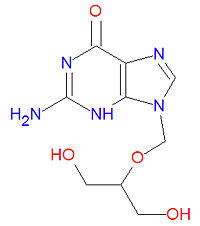Ganciclovir
|
| |||||||
| ganciclovir | |||||||
| |||||||
| Uses: | antiviral drug | ||||||
| Properties: | acyclovir analog | ||||||
| Hazards: | see drug interactions | ||||||
| |||||||
Ganciclovir is an antiviral drug used to treat herpes viruses, particularly cytomegalovirus associated with HIV/AIDS, although other human viruses, including herpes simplex viruses HSV-1 & HSV-2, Epstein-Barr virus and varicella zoster virus are susceptible to this drug in vitro. It is an analog of the natural nucleoside 2-deoxy-guanosine and is a prodrug similar to the drug acyclovir. Ganciclovir is also called ganciclovir sodium and GA2, and it is marketed under the trade names Cytovene®, Cytovene IV®, Cytovene-IV® and Vitrasert®.
Mechanism of action
Like other nucleoside analogs, ganciclovir inhibits the binding and incorporation of the natural DNA nucleoside dATP by becoming incorporated into the viral DNA, leading to defective viral DNA. To become active, the prodrug must be phosphorylated thrice, first by thymidine kinase (TK), then by guanylate kinase, and once more by other cellular enzymes. The reliance on KT limits the pathogens that can be treated with ganciclovir. Because the drug does not contain the correct structure for additional phosphodiester bond formation, DNA synthesis is halted once ganciclovir is inserted into a growing DNA chain.
Chemistry
The IUPAC chemical name of ganciclovir is 2-amino-9-(1,3-dihydroxypropan-2-yloxymethyl)-3H-purin-6-one and it has molecular formula C9H13N5O4, yielding a molecular mass of 255.2306 g/mol. The active form of this drug is the triphosphorylated compound.
External links
The most up-to-date information about Ganciclovir and other drugs can be found at the following sites.
- Ganciclovir - FDA approved drug information (drug label) from DailyMed (U.S. National Library of Medicine).
- Ganciclovir - Drug information for consumers from MedlinePlus (U.S. National Library of Medicine).
- Ganciclovir - Detailed information from DrugBank.
References
see external links
